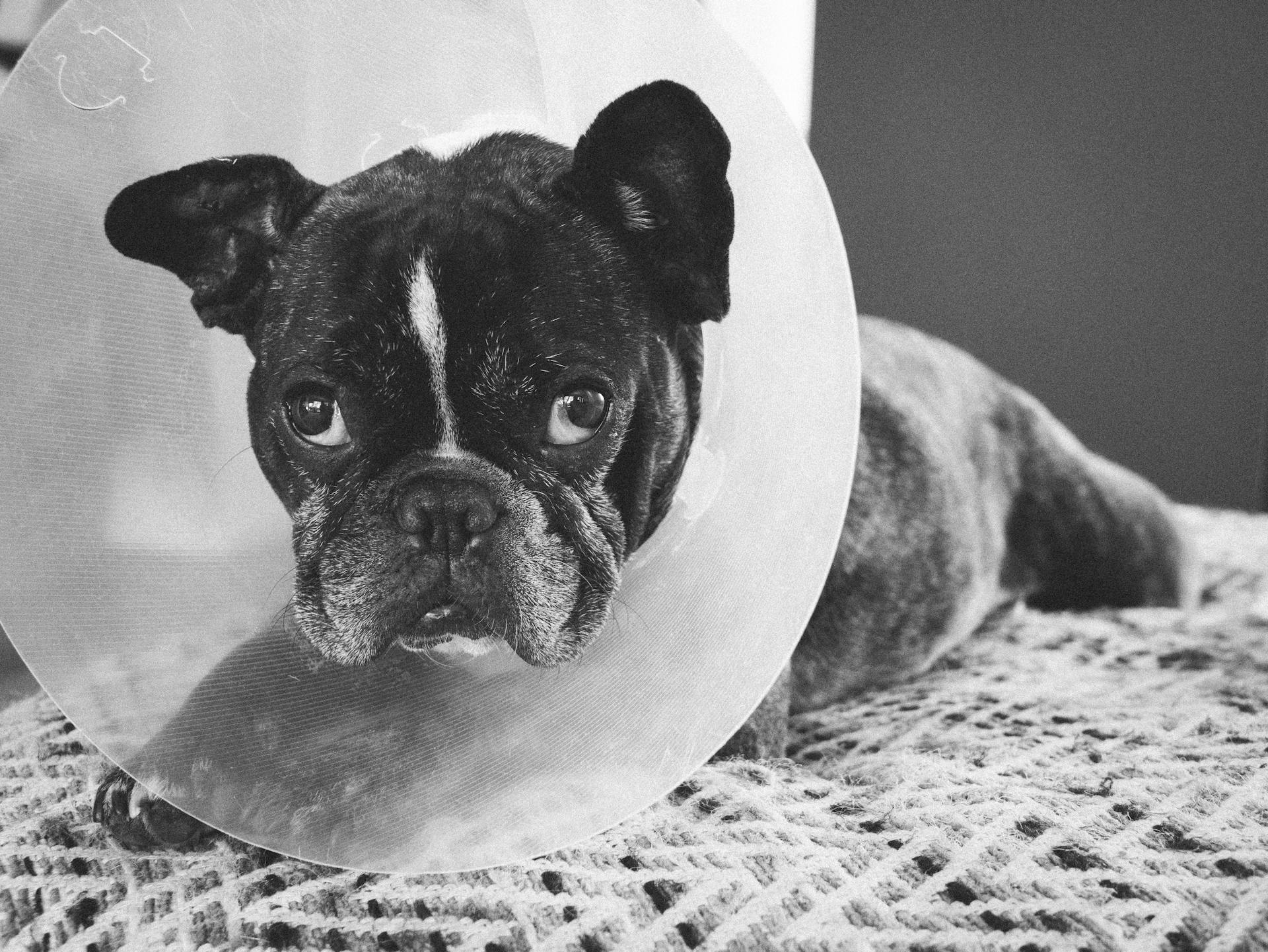
Diagnosing hydrocephalus in French Bulldogs can be a challenge, but it's essential to catch it early. Symptoms often appear between 6-12 weeks of age, but can also develop later in life.
A key indicator of hydrocephalus is a head shape that's significantly larger than normal, which is a result of the brain swelling due to excess fluid. This can be accompanied by a soft spot on the top of the head.
French Bulldogs with hydrocephalus may also exhibit symptoms such as seizures, stumbling, and loss of coordination. These symptoms can be subtle, making it crucial to monitor your puppy closely.
A veterinarian can diagnose hydrocephalus through a combination of physical examination, imaging tests, and clinical signs.
Signs and Symptoms
If you notice any of the following symptoms in your French Bulldog, it's essential to have them thoroughly examined by your veterinarian.
Weak back legs can be a sign of hydrocephalus in dogs, so keep an eye out for any changes in your dog's gait or mobility.
Puppies with congenital hydrocephalus may look normal at birth, but as the CSF builds up in the brain, other symptoms become apparent.
Here are some symptoms you may notice in a puppy with congenital hydrocephalus:
- Seizures
- Stupor
- Coma
- Vision loss
- Lethargy
- Spastic walking
- Head pressing
- Walking in circles
- Slow pace of learning
- Not very responsive to stimuli
- Inappropriate vocalization
- Hyperexcitability
Older dogs with acquired hydrocephalus tend to experience severe symptoms, which can include seizures, stupor, and coma.
Causes and Diagnosis
Hydrocephalus in French Bulldogs requires a veterinary diagnosis.
Hydrocephalus can be congenital, meaning it's present at birth, or acquired, which means it develops over time. A dome-shaped head and open fontanel are often enough to diagnose congenital hydrocephalus.
Diagnosing acquired hydrocephalus is more challenging, as other diseases can cause similar symptoms. Your veterinarian will perform imaging tests, such as ultrasound, CT, or MRI, to confirm the diagnosis.
Causes
Hydrocephalus in dogs occurs when there's an abnormal amount of cerebrospinal fluid within the skull, putting pressure on the brain and causing severe problems.
Congenital hydrocephalus is a birth defect that can be difficult to diagnose in young dogs, especially when they're very young and don't yet show obvious symptoms.

A large open fontanel on the top of the skull is a common sign of congenital hydrocephalus, but not all dogs with this feature will develop the condition.
Hydrocephalus can also be acquired, which means it develops later in life, but the exact causes of acquired hydrocephalus are not specified in the text.
How to Diagnose
Diagnosing hydrocephalus in dogs requires a veterinary diagnosis. Your veterinarian will examine your dog to look for clinical symptoms such as a large open fontanel and lack of coordination when walking.
The presence of a dome-shaped head and open fontanel can be enough to diagnose congenital hydrocephalus.
Your veterinarian will perform imaging tests of your dog's brain, including ultrasound, to determine the severity of hydrocephalus. Ultrasound is a good option for puppies with an open fontanel because it allows your veterinarian to see your dog's brain.
Advanced diagnostic imaging options, such as computed tomography (CT) and magnetic resonance imaging (MRI), may be recommended for dogs without an open fontanel but suspected of having hydrocephalus. These tests require anesthesia.
CSF analysis can help determine the underlying cause of acquired hydrocephalus, such as inflammatory cells in the CSF indicating an infection.
Related reading: National Dog Show French Bulldog 2023
Treatment Options
Early treatment is key to success, so it's essential to catch hydrocephalus in its early stages.
Your veterinarian will determine the best treatment option for your French Bulldog according to their age, neurologic status, and severity of symptoms.
For mild to moderate hydrocephalus, treatment typically begins with medications to reduce inflammation and brain swelling, increase the outflow of cerebrospinal fluid (CSF), and decrease CSF production.
Medications may include steroids, diuretics, omeprazole, and anti-seizure medications.
In severe cases or if medications aren't working, surgical placement of a ventriculoperitoneal shunt may be recommended.
This shunt redirects the flow of CSF into the abdomen and is a long-term treatment solution with a success rate between 50 and 90 percent.
However, shunt placement is complex and not without risk, and many veterinarians are not comfortable performing this surgery.
Some common complications of shunt placement include shunt blockage and infection within the shunt.
Here are some common medications used to treat hydrocephalus in French Bulldogs:
- Steroids to reduce inflammation and brain swelling
- Diuretics to increase the outflow of CSF and decrease CSF production
- Omeprazole to reduce CSF production
- Anti-seizure medications
Recovery and Life Expectancy
Recovery from hydrocephalus in French Bulldogs can be a lengthy process, and the prognosis varies depending on the severity of the condition. Puppies with congenital hydrocephalus can do well if treatment begins promptly.
Supportive care may be the only course of action in extreme cases, with the goal of keeping your dog comfortable. This can be a challenging and emotionally draining experience for pet owners.
The life expectancy for dogs with hydrocephalus depends on several factors, including the dog's age and the severity of the condition. Puppies with congenital hydrocephalus can have a good outlook if they receive shunt surgery before severe brain damage occurs.
Consider reading: Dog Food for French Bulldogs with Allergies
Recovery
Recovery is a crucial aspect of hydrocephalus in dogs. The recovery time depends on the severity of the condition.
In extreme cases, supportive care may be the only course of action to keep your dog comfortable. This can be a challenging time for pet owners.
Puppies with congenital hydrocephalus generally do well once treatment has begun. This is especially true if there hasn't been severe brain damage.
Dogs diagnosed with acquired hydrocephalus have varying recovery times and prognoses. This depends on the underlying cause and the ability to treat the condition.
Discussing your dog's prognosis and recovery time with your veterinarian is essential. They can provide personalized guidance and support throughout your dog's journey.
Recommended read: National Dog Show French Bulldog
Life Expectancy

Puppies with congenital hydrocephalus can do well if they have shunt surgery before severe brain damage has occurred.
The life expectancy for dogs with hydrocephalus depends on several factors, including the dog's age and how severe and longstanding the hydrocephalus is.
Older dogs with acquired hydrocephalus have a more guarded prognosis because of the severity of the underlying condition.
Shunt surgery can be expensive, with costs ranging in the thousands of dollars.
Hydrocephalus is a serious and life-threatening condition, so prompt diagnosis and treatment are crucial.
Puppy's Second Chance
Herbie, a French Bulldog puppy, has a big, fighting heart despite being just a few weeks old and struggling with hydrocephalus, or water on the brain.
He was dropped off at a foster home unable to walk or stand, a condition that often ends in euthanasia for dogs.
The rescue group, Road Dogs & Rescue, and his foster mom worked hard to help Herbie, bringing him to a canine rehabilitation center in Los Angeles.
Herbie's progress has been exciting to watch, with staff fitting him with a tiny wheelchair and teaching him how to walk.
He's getting stronger every day, with video of his intensive therapy getting thousands of views on social media.
A neurologist who treated Herbie says he'll be eligible for surgery to drain excess fluid on his brain when he's 6-months-old, possibly giving him a happy, healthy life like many dogs.
Frequently Asked Questions
Can hydrocephalus be cured in dogs?
Hydrocephalus in dogs can be managed with treatment, but a cure is not always possible. Recovery and prognosis vary depending on the underlying cause and severity of the condition
Sources
- https://wagwalking.com/condition/hydrocephalus
- https://www.ncbi.nlm.nih.gov/pmc/articles/PMC4751777/
- https://pubmed.ncbi.nlm.nih.gov/26933271/
- https://www.dailypaws.com/dogs-puppies/health-care/dog-conditions/hydrocephalus-in-dogs
- https://www.wkyc.com/article/news/puppy-with-fluid-on-the-brain-gets-second-shot-at-life/95-255541192
Featured Images: pexels.com


